abaxial: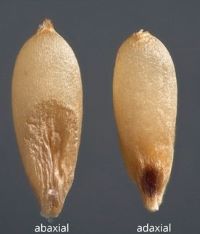 dorsal; on the side that is away from the axis (in nutlets, the side facing outwards); (compare adaxial)
dorsal; on the side that is away from the axis (in nutlets, the side facing outwards); (compare adaxial)
accrescent: growing continuously
achene: a dry, indehiscent, one-seeded fruit, with seed attached to pericarp at a single point
a dry, indehiscent, one-seeded fruit, with seed attached to pericarp at a single point
acuminate: tapering gradually to a point and forming more or less concave sides
tapering gradually to a point and forming more or less concave sides
acute: tapering to a pointed apex with more or less straight sides
tapering to a pointed apex with more or less straight sides
adaxial: ventral; on the side that is towards the axis (in nutlets, the side facing inwards), (compare abaxial)
ventral; on the side that is towards the axis (in nutlets, the side facing inwards), (compare abaxial)
aggregate: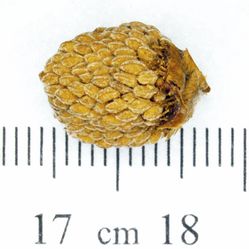 fruit formed from a single flower with carpels several and distinct
fruit formed from a single flower with carpels several and distinct
alveolate: surface relief—reticulated, honeycombed; ridges that intersect to form polygonal cells with a regular size and shape similar to a honeycomb
surface relief—reticulated, honeycombed; ridges that intersect to form polygonal cells with a regular size and shape similar to a honeycomb
angular: 2D shape—having sides that meet at acute or obtuse angles
annular: 3D shape—forming a ring
3D shape—forming a ring
anomalicidal: type of capsular dehiscence, opening irregularly
anthocarp: simple or compound and including some tissue of non-ovarian origin (accessory tissue)
simple or compound and including some tissue of non-ovarian origin (accessory tissue)
antrorse: (adv. antrorsely) curved or bent toward the apex (as in 'antrorsely barbed')
apex: the point farthest from the point of attachment, or the "tip" of an organ
the point farthest from the point of attachment, or the "tip" of an organ
apical: at or pertaining to the end of the seed or fruit distal from its point of attachment (i.e., base)
apocarpous: gynoecium with two or more distinct carpels
appressed: pressed close to or lying flat against something, as in hairs on grass bract
aril: (broad sense) appendicular structure that wholly or partly envelops a seed and is produced from or a modification of the funicle, raphe, or outer integument; usually fleshy or pulpy, sometimes spongy or tufted-capillate, often brightly colored
(broad sense) appendicular structure that wholly or partly envelops a seed and is produced from or a modification of the funicle, raphe, or outer integument; usually fleshy or pulpy, sometimes spongy or tufted-capillate, often brightly colored
aristate: having a bristle-like appendage (e.g., awn)
having a bristle-like appendage (e.g., awn)
article: section of a fruit separated from other sections by a constricted joint
section of a fruit separated from other sections by a constricted joint
awn: a narrow, bristle-like organ, as on the glumes or lemmas of grasses
a narrow, bristle-like organ, as on the glumes or lemmas of grasses
axial: (of embryo) embryo is situated along the longitudinal axis of the seed and may partially or completely fill the seed
axile: on or of the axis
axis: a straight line through the center of a structure around which the parts are usually symmetrically arranged, as in the stem or rachis of an inflorescence
barbed: (of awns or bristles) with short, sharp, hair-like projections
barbellate: finely or minutely barbed; covered with short, hooked bristles or hairs
basal: at or pertaining to the point of attachment; (of embryo) embryo occupies one end of the seed
beak: a usually firm, terminal appendage, sometimes tapered
a usually firm, terminal appendage, sometimes tapered
bent: (of embryo) embryo is bent at an acute, V-shaped angle with the ends close together and generally thick cotyledons
(of embryo) embryo is bent at an acute, V-shaped angle with the ends close together and generally thick cotyledons
berry: an indehiscent, fleshy fruit with one or a few to many seeds. The flesh may be homogenous throughout. Or, if the outer part is hard, firm, or leathery, referred to as an hesperidium. Septa are present in some, and the seeds may be arillate or with a fleshy testa.
an indehiscent, fleshy fruit with one or a few to many seeds. The flesh may be homogenous throughout. Or, if the outer part is hard, firm, or leathery, referred to as an hesperidium. Septa are present in some, and the seeds may be arillate or with a fleshy testa.
bifid: two-lobed or two-cleft (usually in reference to an apex)
two-lobed or two-cleft (usually in reference to an apex)
bilocular: (ovary or fruit) having two locules
biseriate: arranged in two rows; e.g. seeds arranged in two rows within a locule
blistered: surface relief—covered with irregular raised, hollow granules that give the surface a bubbled appearance
surface relief—covered with irregular raised, hollow granules that give the surface a bubbled appearance
bony: very hard and rather brittle, like bone
bract: a leaf-like or scale-like plant part, located just below a fruit (especially in grasses), flower, flower stalk, or an inflorescence
a leaf-like or scale-like plant part, located just below a fruit (especially in grasses), flower, flower stalk, or an inflorescence
bristly: having bristles or stiff hair or hair-like structures
having bristles or stiff hair or hair-like structures
C-shaped: 2D-shape—semiannulate, curved into the shape of the letter 'C'
callus:.jpg) the hard base of grass florets or spikelets, just above the point of disarticulation
the hard base of grass florets or spikelets, just above the point of disarticulation
calyx: the outer whorl of the perianth; all the sepals of a flower
the outer whorl of the perianth; all the sepals of a flower
campanulate: 3D shape—bell-shaped, circular in cross-section, inflated proximally, broadening gradually until flared distally
capitate: head-shaped; abruptly enlarged on one end to a relatively short, terminal portion
capsule: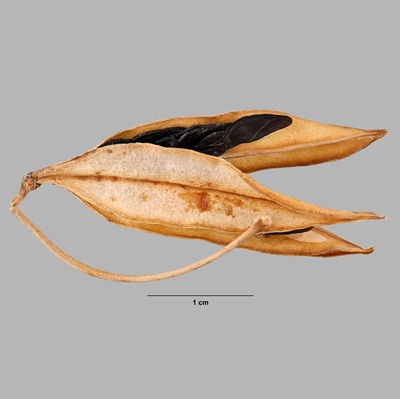 a dry, dehiscent fruit formed by two or more carpels
a dry, dehiscent fruit formed by two or more carpels
carcerulus: simple, multicarpellate, indehiscent fruit consisting of one or more seeds and air space enclosed by an undifferentiated pericarp (Spjut 1994)
carpel: a simple pistil that consists of a single ovary, style, and stigma
carpophore: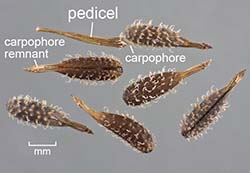 the stalk supporting a mericarp after dehiscence of a schizocarpic fruit, the central axis of the fruit having split longitudinally to yield two or four such stalks; composed of receptacular and (primarily) gynoecial tissues, esp. in Apiaceae
the stalk supporting a mericarp after dehiscence of a schizocarpic fruit, the central axis of the fruit having split longitudinally to yield two or four such stalks; composed of receptacular and (primarily) gynoecial tissues, esp. in Apiaceae
carpopodium: an elongation of the base of the gynoecium which looks distinct, as in the cypselae of some Asteraceae
an elongation of the base of the gynoecium which looks distinct, as in the cypselae of some Asteraceae
cartilaginous: texture—firm, dense, tough, somewhat pliable, and resilient, like cartilage
caruncle: a localized outgrowth of the seed coat near the hilum of the seed; it functions as an elaiosome
a localized outgrowth of the seed coat near the hilum of the seed; it functions as an elaiosome
caryopsis: a small, indehiscent, dry, fruit with a thin wall surrounding and more or less fused to a single seed
a small, indehiscent, dry, fruit with a thin wall surrounding and more or less fused to a single seed
caudate: tapering to a long, tail-like appendage
tapering to a long, tail-like appendage
ceratium capsule: capsular fruit that opens by a separation or break in the pericarp layers, usually the inner parts—replum, styles, parietal placentae—persistent and often setaceous, skeletal or partitional, or the endocarp dehiscent (Spjut 1994)
cerebriform: an irregular brain-like appearance, as the kernel of a walnut
chalaza: the region at the base of the ovule where the integuments are inserted
the region at the base of the ovule where the integuments are inserted
chartaceous: =papery, papyraceous
ciliate: with a marginal fringe of hairs
circinate: 3D shape—terete and rolled downward from the apex in a tight coil
circular: (of embryo) linear embryo is curved into an "O" shape
(of embryo) linear embryo is curved into an "O" shape
circumscissile: (~pyxis); type of capsular dehiscence, opens by a lid (splitting transversely)
(~pyxis); type of capsular dehiscence, opens by a lid (splitting transversely)
clathrate: latticelike in appearance
clavate: 3D shape—club-shaped, with attachment at or near narrow end (compare obclavate)
3D shape—club-shaped, with attachment at or near narrow end (compare obclavate)
claviform: 3D shape—club-shaped
coccus: fruitlets, derived from a schizocarpous gynoecium, opening along their ventral sutures and sometimes the dorsal sutures as a result of their separation from one another or from a central axis (Spjut 1994, slight modification)
cochleate: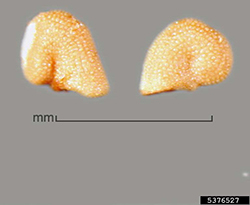 snail-shell-shaped. Relatively broad and short, basically round in transverse section, resembling a rapidly tapering spire overall, the exterior helically convoluted; like a snail shell
snail-shell-shaped. Relatively broad and short, basically round in transverse section, resembling a rapidly tapering spire overall, the exterior helically convoluted; like a snail shell
coiled: (of embryo) linear embryo is very long and bent to form a coil whereby one end of the embryo is on the outside and the other end near the middle of the seed
(of embryo) linear embryo is very long and bent to form a coil whereby one end of the embryo is on the outside and the other end near the middle of the seed
colliculate: surface relief—covered with small, round projections, similar to blistered
surface relief—covered with small, round projections, similar to blistered
columella: any pedestal-like prolongation of a floral receptacle extending beyond the distalmost level of perianth insertion and bearing the gynoecium; the stalk supporting a mericarp after dehiscence of a schizocarpic fruit, the central axis of the fruit having split longitudinally to yield two or four such stalks; composed of receptacular and (primarily) gynoecial tissues, especially in Apiaceae. See carpophore.
coma: a tuft of hairs, often attached to the tip of seeds
commissure: the face along which two carpels join, as in the Apiaceae
the face along which two carpels join, as in the Apiaceae
compressed: flattened; in grasses, used to denote compression (not necessarily flattened) either laterally or dorsiventrally
conical: 3D shape—cone-shaped, with the point of attachment at the broad end
3D shape—cone-shaped, with the point of attachment at the broad end
connivent: converging but not fused
cordate: 2D shape—heart-shaped, with attachment at or near the broad end (compare obcordate)
2D shape—heart-shaped, with attachment at or near the broad end (compare obcordate)
cordiform: 3D shape—heart-shaped
coriaceous: texture—leathery
corky: firm, relatively light, discontinuous but strongly cohesive, and resilient
corolla: the inner whorl(s) of the perianth; all the petals of a flower
the inner whorl(s) of the perianth; all the petals of a flower
cotyledon: a primary leaf of the embryo
a primary leaf of the embryo
craspedium: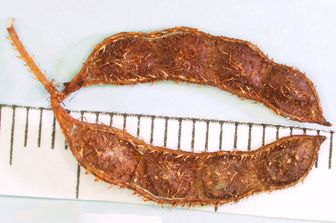 a one-carpellate fruit splitting transversely into one-seeded segments; seed-bearing segments separate from each other and from the persistent sutures
a one-carpellate fruit splitting transversely into one-seeded segments; seed-bearing segments separate from each other and from the persistent sutures
crenate: having a margin with low, rounded or scalloped projections
having a margin with low, rounded or scalloped projections
crenulate: finely crenate (scalloped)
crescent-shaped: 2D shape—arcuate or curved, broadest at the middle, and attenuate to acute ends; like a stylized outline of a first-quarter moon
2D shape—arcuate or curved, broadest at the middle, and attenuate to acute ends; like a stylized outline of a first-quarter moon
crisped: irregularly curled, wavy or crinkled
cristate: with a crest
crustaceous: texture—thin, dry, indurate, and brittle
cuneiform: =wedge-shaped
curved: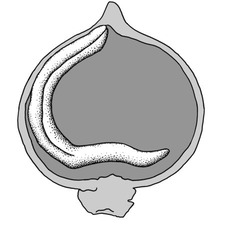 (of embryo) linear embryo is curved into an arch or horseshoe with the ends far apart
(of embryo) linear embryo is curved into an arch or horseshoe with the ends far apart
cylindrical: 3D shape—a cylinder, with parallel sides and a circular cross-section; tubular or rod-shaped
cymbiform: 3D shape - boat-shaped, navicular
cypsela: dry, indehiscent, unilocular fruit with a single seed not adnate to the pericarp, similar to an achene but developed from an inferior ovary. Fruit type of Asteraceae.
D-shaped: 2D shape—has one straight margin and one curved margin, resembling the shape of the letter D
deciduous: falling off; not persistent
dehiscent: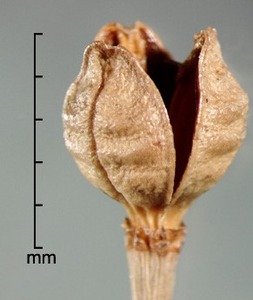 (v. dehisce) splitting open at maturity to release contents (of a fruit)
(v. dehisce) splitting open at maturity to release contents (of a fruit)
dentate: regularly spaced, teeth oriented more or less perpendicular to the central axis bearing them
regularly spaced, teeth oriented more or less perpendicular to the central axis bearing them
denticidal: type of capsular dehiscence, fruit opening by a series of apical teeth
didymous: 3D shape—paired, usually inflated and appears as two globose to ovoid halves pressed together
dimorphic: occurring in two forms
dioecious: having separate male and female flowers or cones on different individuals of the same species
discoid: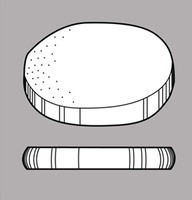 3D shape—resembling a disc
3D shape—resembling a disc
disseminule: detachable plant part capable of being disseminated and of propagating, commonly a seed or fruit
dolabriform: 3D shape—axe-shaped, elongate, basally terete, becoming strongly compressed toward an abruptly and unilaterally broader apex
dorsal: abaxial; the back of an organ; the side away from the axis (compare ventral)
abaxial; the back of an organ; the side away from the axis (compare ventral)
dorsally compressed: fruit or seed compressed in one plane bringing the back (outer surface, or surface facing away from the axis) closer to the front (inner surface, or surface facing the axis)
dorsiventral: pertaining to the dorsal and ventral surfaces
drupe: (indehiscent drupe) a fleshy, indehiscent fruit with one more hard pits enclosing seeds; (dehiscent drupe) a fruit with a dry or fibrous to fleshy or leathery outer husk that early to tardily breaks apart (or opens), exposing one or more nutlike pits enclosing the seeds
(indehiscent drupe) a fleshy, indehiscent fruit with one more hard pits enclosing seeds; (dehiscent drupe) a fruit with a dry or fibrous to fleshy or leathery outer husk that early to tardily breaks apart (or opens), exposing one or more nutlike pits enclosing the seeds
drupelet: one drupe of a fruit with multiple drupes, as in blackberries
dry: texture—free or relatively free from water or liquid
dull: reflecting only a low proportion of incident light, with no apparent sheen
reflecting only a low proportion of incident light, with no apparent sheen
elaiosome: a lipid and protein-rich fleshy structure attached to some seeds and fruits, it attracts ants which then disperse the disseminule (e.g., caruncle in the Euphorbiaceae, the aril (outgrowth of the funiculus) in the Fabaceae)
a lipid and protein-rich fleshy structure attached to some seeds and fruits, it attracts ants which then disperse the disseminule (e.g., caruncle in the Euphorbiaceae, the aril (outgrowth of the funiculus) in the Fabaceae)
ellipsoid: 3D shape—elliptic
elliptic: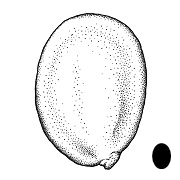 2D shape—oval, oblong-like with the 2 ends narrowing and more or less alike
2D shape—oval, oblong-like with the 2 ends narrowing and more or less alike
emarginate: with a shallow notch at apex
with a shallow notch at apex
endocarp: the inner layer of the pericarp, if divided into layers
the inner layer of the pericarp, if divided into layers
endosperm: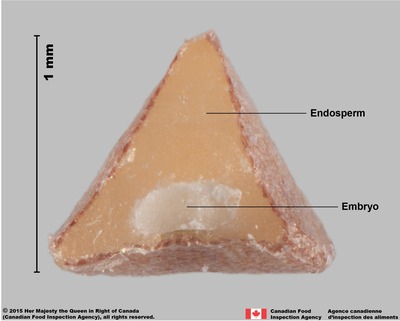 nutritive starch- and oil-containing tissue present in many seeds
nutritive starch- and oil-containing tissue present in many seeds
epicarp: outer layer of fruit wall or pericarp, if divided into layers; note here used synonymously with exocarp
outer layer of fruit wall or pericarp, if divided into layers; note here used synonymously with exocarp
exocarp: outer layer of fruit wall or pericarp, if divided into layers; note here used synonymously with epicarp
outer layer of fruit wall or pericarp, if divided into layers; note here used synonymously with epicarp
falcate: shaped like a scythe or sickle
shaped like a scythe or sickle
fascicle: a highly reduced branch of a spicate grass panicle consisting of 1–3 whorls of free or fused bristles disarticulating with the spikelets at maturity
fertile floret: a grass floret capable of producing fruit; the fertile floret may possess both male and female, or just female, reproductive structures
a grass floret capable of producing fruit; the fertile floret may possess both male and female, or just female, reproductive structures
fibrous: texture—long, flexible threads, thicker than hairs, that densely cover and obscure the surface
texture—long, flexible threads, thicker than hairs, that densely cover and obscure the surface
filled: (of embryo) embryo fills the seed interior with the food reserves stored in the cotyledons; small amounts of endosperm may remain around the embryo
(of embryo) embryo fills the seed interior with the food reserves stored in the cotyledons; small amounts of endosperm may remain around the embryo
firm: texture—yielding under only moderately strong pressure; only slightly deformable without internal structural disruption
flanged: with a projecting rim or edge
flask-shaped: 3D shape—generally circular in cross-section, broadest at or below the middle, approximately globose below that and constricted above to a relatively narrow neck
fleshy: texture—fairly firm and dense, juicy or at least moist, and easily cut
floret: the unit of a grass spikelet consisting of a flower or caryopsis, with lemma and palea
the unit of a grass spikelet consisting of a flower or caryopsis, with lemma and palea
foliate: appearing leaf-like
follicle: a dry to (rarely) fleshy fruit derived from a single carpel that opens along a single longitudinal suture; the seeds may be arillate or with a fleshy testa
a dry to (rarely) fleshy fruit derived from a single carpel that opens along a single longitudinal suture; the seeds may be arillate or with a fleshy testa
foraminicidal: type of capsular dehiscence, fruits opening irregularly
funiculus: (alt. funicle) stalk connecting the ovule (later seed) to the ovary (later fruit) placenta
(alt. funicle) stalk connecting the ovule (later seed) to the ovary (later fruit) placenta
fusiform: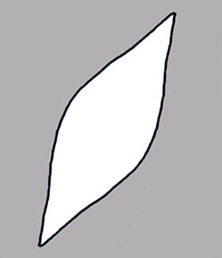 spindle-shaped; broadest at the middle and tapering at both ends
spindle-shaped; broadest at the middle and tapering at both ends
geniculate: bent like a knee
gibbous: swollen on one side
swollen on one side
glabrous: without hairs
glandular: surface relief—covered with small, raised secretory glands, regular or irregularly shaped, translucent or opaque, and maybe distinctly colored
surface relief—covered with small, raised secretory glands, regular or irregularly shaped, translucent or opaque, and maybe distinctly colored
glistening: sparkling with reflected light
globose: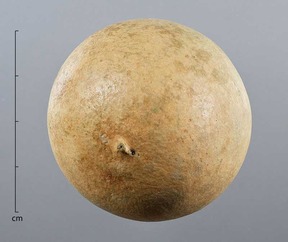 3D shape—more or less spherical
3D shape—more or less spherical
glossy: shiny
shiny
glume: one of the (usually) two bracts at the base of a grass spikelet
one of the (usually) two bracts at the base of a grass spikelet
granular: surface relief—having a grainy surface
surface relief—having a grainy surface
grooved: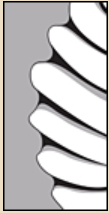 surface relief—linear depressions that may be single or form a series of grooves over the surface
surface relief—linear depressions that may be single or form a series of grooves over the surface
gynobase: an elongation or enlargement of the receptacle
an elongation or enlargement of the receptacle
gynophore: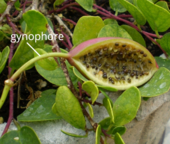 stalk-like basal portion of the ovary, bearing the main body of the pistil at its summit
stalk-like basal portion of the ovary, bearing the main body of the pistil at its summit
heart-shaped: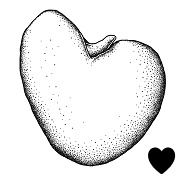 2D or 3D shape—one end has prominent double curved into two lobes, the other end angular or pointed
2D or 3D shape—one end has prominent double curved into two lobes, the other end angular or pointed
hemispherical: 2D shape—shaped like half a sphere
hesperidium: a specialized berry, in which the outer layer is hard, firm, or leathery
hilar: of or relating to a hilum
hilum: on seeds, the scar indicating where the funiculus was attached; on grass caryopses, the scar visible on the outer fruit surface revealing where the seed is attached on the inner fruit wall surface; or in Asteraceae cypselae, the scar visible on the outer fruit wall revealing where the fruit was attached to the receptacle
on seeds, the scar indicating where the funiculus was attached; on grass caryopses, the scar visible on the outer fruit surface revealing where the seed is attached on the inner fruit wall surface; or in Asteraceae cypselae, the scar visible on the outer fruit wall revealing where the fruit was attached to the receptacle
hippocrepiform: 3D shape—horseshoe-shaped
honeycombed: surface relief—raised walls (a reticulum) surround depressed interspaces called interstices
surface relief—raised walls (a reticulum) surround depressed interspaces called interstices
horn: a straight or curved, slenderly conic or conoidal protrusion, resembling an animal horn
horseshoe-shaped: 3D shape—relatively slender and strongly compressed, the whole strongly curved over its length in a plane perpendicular to the
direction of compression and forming an incomplete circle, the ends somewhat straighter than the rest and parallel or nearly so
3D shape—relatively slender and strongly compressed, the whole strongly curved over its length in a plane perpendicular to the
direction of compression and forming an incomplete circle, the ends somewhat straighter than the rest and parallel or nearly so
hyaline: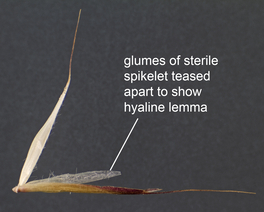 thin, membranous, and translucent or transparent
thin, membranous, and translucent or transparent
hypocotyl: portion of the embryonic axis below the cotyledons and above the radicle
hypostase: a disk of lignified tissue formed at the base of the ovule
incumbent: (of cotyledons) having the dorsal side of one cotyledon resting against the radicle
(of cotyledons) having the dorsal side of one cotyledon resting against the radicle
indehiscent: not opening on its own, as in a fruit
not opening on its own, as in a fruit
indurate: texture—hardened or stony; yielding under strong pressure; not deformable without internal structural disruption
inferior: ovary wholly enclosed by a floral tube casing, the distal portions of the perianth and/or androecium thus arising from its apex
infructescence: mature (fruiting) inflorescence
integument: ring-like or hood-like structure(s) that envelopes the nucellus, at maturity is the layers of the seed coat
ring-like or hood-like structure(s) that envelopes the nucellus, at maturity is the layers of the seed coat
internode: portion of a stem between two nodes
investing: (of embryo) embryo is nearly or completely filling seed coat, straight, and axile and centric with spatulate cotyledons and covering the stalk for at least half its length; (of cotyledons) cotyledons spatulate and covering the stalk for at least half its length
involucre: in the grasses, a whorl or cluster of bracts or bristles subtending a floret or spikelet
in the grasses, a whorl or cluster of bracts or bristles subtending a floret or spikelet
isthmus: (pl. isthmi) a narrow strip of tissue connecting two larger parts
keel: a longitudinal ridge, like the keel of a boat, formed by the lengthwise folding of a structure, such as a lemma or palea
a longitudinal ridge, like the keel of a boat, formed by the lengthwise folding of a structure, such as a lemma or palea
kidney-shaped: 2D shape—broadly elongate and with one margin convex and the opposite side concave, each end bluntly rounded
2D shape—broadly elongate and with one margin convex and the opposite side concave, each end bluntly rounded
knotted: 3D shape—a cylindrical or ellipsoid body that is swollen and constricted at intervals; torulose
3D shape—a cylindrical or ellipsoid body that is swollen and constricted at intervals; torulose
lanceolate: 2D shape—lance-shaped; much longer than wide, with widest point below the middle, tapering to the apex (compare oblanceolate)
2D shape—lance-shaped; much longer than wide, with widest point below the middle, tapering to the apex (compare oblanceolate)
lanceoloid: 3D shape—lanceolate
lateral: (of embryo) embryo lies along the side of the seed, generally towards one end; of, at, or from the side; in grasses, can refer to the sides adjacent to the dorsal and ventral sides
laterally compressed: fruit or seed compressed in one plane at the sides bringing them closer together
leathery: texture—moderately thick, tough, and very pliable
legume: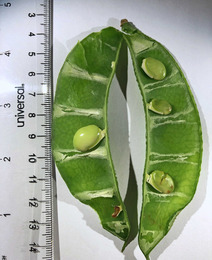 a usually dry, dehiscent fruit derived from a single carpel that opens along two longitudinal sutures
a usually dry, dehiscent fruit derived from a single carpel that opens along two longitudinal sutures
lemma: in grasses, the lower of the two bracts subtending the flower or caryopsis (compare palea)
in grasses, the lower of the two bracts subtending the flower or caryopsis (compare palea)
lens: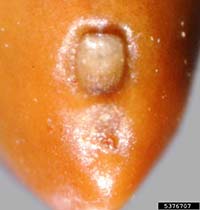 a mound, pad, or area of tissue situated near the hilum on seeds in the Mimosoideae and Caesalpinioideae
a mound, pad, or area of tissue situated near the hilum on seeds in the Mimosoideae and Caesalpinioideae
lens-shaped: 2D shape—round and flattened with two curved (convex) surfaces
lenticular: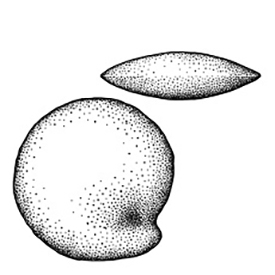 3D shape—lens-shaped; biconvex
3D shape—lens-shaped; biconvex
ligneous: woody
linear: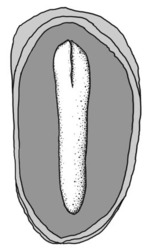 (shape) long, narrow, and uniform in width; (of embryo) embryo is straight and much longer than wide
(shape) long, narrow, and uniform in width; (of embryo) embryo is straight and much longer than wide
locule: structurally distinct compartment with the fruit
loculicidal: type of capsular dehiscence, opening longitudinally through the locules (compare septicidal)
type of capsular dehiscence, opening longitudinally through the locules (compare septicidal)
loment: a usually dry fruit derived from a single carpel that breaks transversely into one-seeded fruit segments
a usually dry fruit derived from a single carpel that breaks transversely into one-seeded fruit segments
lomentoid: resembling a loment
longitudinal: of or relating to length or the lengthwise dimension
lustrous: semiglossy
macropodous: an embryo having an enlarged or elongated hypocotyl
marginal: at, on, or close to the margin or border
mealy: loose, dry, and disintegrating in finely granular pieces like meal or flour
membranous: texture—extremely thin, pliable, and fairly tough
mericarp: a one-seeded section (carpel) of a schizocarp, as in Apiaceae fruits (compare schizocarp)
a one-seeded section (carpel) of a schizocarp, as in Apiaceae fruits (compare schizocarp)
mesocarp: the middle layer of the pericarp, if divided into layers
the middle layer of the pericarp, if divided into layers
micropylar collar: collar shaped tissue at micropyle
micropyle: an opening in the integuments of an ovule usually acting as a passage for the pollen tube
an opening in the integuments of an ovule usually acting as a passage for the pollen tube
mitaform: shaped like a child's mitten
moniliform: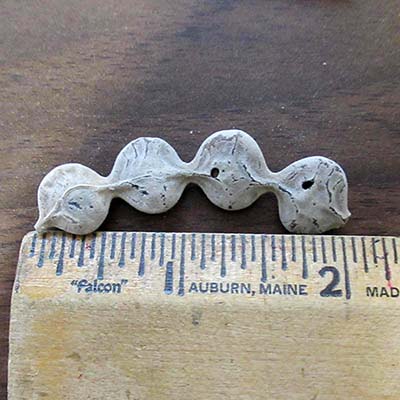 elongate, relatively slender, transversely round, and more or less regularly constricted over its length, the whole straight or variously curved; like a necklace of beads, see torulose
elongate, relatively slender, transversely round, and more or less regularly constricted over its length, the whole straight or variously curved; like a necklace of beads, see torulose
monocarpellary: ovary or fruit having one carpel
monoecious: having separate male and female flowers on the same individual
mottled: with colored spots, streaks, or blotches of a different color
with colored spots, streaks, or blotches of a different color
mucilaginous: resembling mucilage; moist and sticky
mucronate: terminating with a short, sharp, abrupt tip
terminating with a short, sharp, abrupt tip
mucronulate: diminutive of mucronate
diminutive of mucronate
multiple: fruit formed from several flowers clustered in one mass
multiseriate: occurring in more than one series
muricate: surface relief—rough with small, hard, sharp projections
myxogenic: mucilaginous when wetted
nucellus: complex structure that produces and encloses the megagametophyte (embryo sac)
nut: a fairly large, indehiscent, dry fruit with a thick and bony wall surrounding a single seed
a fairly large, indehiscent, dry fruit with a thick and bony wall surrounding a single seed
nutlet: ˜achene
nutritive tissue: tissue within the seeds that nourishes the developing embryo; such as endosperm, perisperm, or chalazosperm in angiosperms; megagametophyte in gymnosperms
obclavate: 3D shape—club-shaped, with attachment at or near the broad end (compare clavate)
3D shape—club-shaped, with attachment at or near the broad end (compare clavate)
obconic: 2D shape—cone-shaped, with attachment at or near the narrow end
obconical: 3D shape—inversely cone-shaped, with point of attachment at narrow end
obcordate: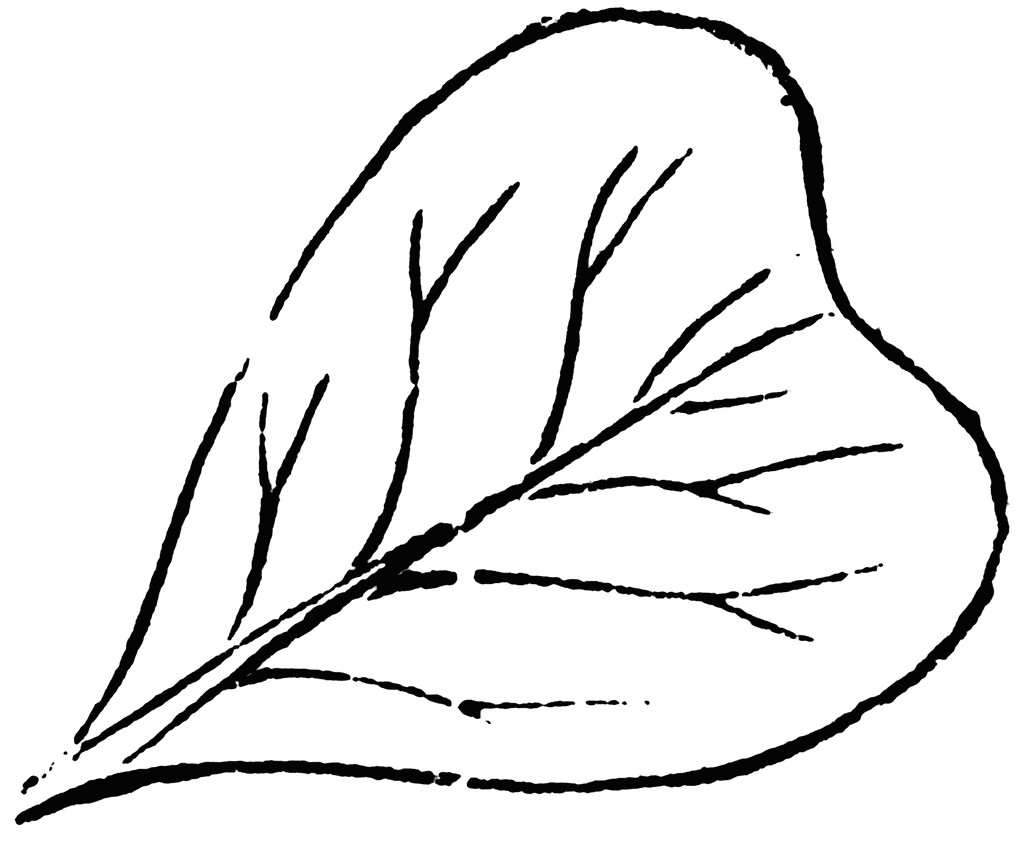 2D shape—heart-shaped, with attachment at or near the narrow end (compare cordate)
2D shape—heart-shaped, with attachment at or near the narrow end (compare cordate)
oblanceolate: 2D shape—lance-shaped, with attachment at or near the narrow end (compare lanceolate)
2D shape—lance-shaped, with attachment at or near the narrow end (compare lanceolate)
oblate: depressed globose
oblique: in a slanting direction or position, neither horizontal nor vertical
oblong: 2D shape—much longer than broad with nearly parallel sides, corners are rounded
2D shape—much longer than broad with nearly parallel sides, corners are rounded
obovate: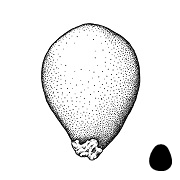 2D shape—ovate or egg-shaped in outline, with attachment at or near the narrow end (compare ovate, ovoid)
2D shape—ovate or egg-shaped in outline, with attachment at or near the narrow end (compare ovate, ovoid)
obovoid: 3D shape—obovate
obpyramidal: 3D shape—pyramid-shaped, with point of attachment at or near narrow end (compare pyramidal)
obtriangular: 2D shape—inversely triangular, with point of attachment at narrow end
2D shape—inversely triangular, with point of attachment at narrow end
obtuse: with a blunt or rounded apex
with a blunt or rounded apex
opaque: not transmitting light
operculum: a dehiscent cap (or lid) of a seed or fruit that opens during germination or dehiscence
a dehiscent cap (or lid) of a seed or fruit that opens during germination or dehiscence
orbicular: 2D shape—circular in outline, 3D shape—globose
2D shape—circular in outline, 3D shape—globose
orthodox: (of seed) seed that can be dried to low moisture levels
oval: 2D shape—elongate, widest at the middle, and symmetrically convex-attenuate to rounded ends
2D shape—elongate, widest at the middle, and symmetrically convex-attenuate to rounded ends
ovate: 2D shape—egg-shaped in outline, widest point is towards one end of the organ, the other end tapers gradually, attachment at or near the broad end (compare obovate, ovoid)
2D shape—egg-shaped in outline, widest point is towards one end of the organ, the other end tapers gradually, attachment at or near the broad end (compare obovate, ovoid)
ovoid: 3D shape—ovate
3D shape—ovate
ovule: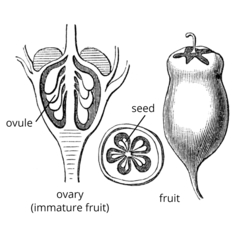 organ that contains the egg and after fertilization, becomes the seed
organ that contains the egg and after fertilization, becomes the seed
palea: in grasses, the uppermost bract enclosing the flower or caryopsis (compare lemma)
in grasses, the uppermost bract enclosing the flower or caryopsis (compare lemma)
panduriform: 3D shape—fiddle-shaped, obovate with deep, rounded sinuses opposite one another
papery: texture—papyraceous, chartaceous; very thin, pliable, and readily torn; like paper
papilla: a minute, distinct, broad-based projection, tapering to a rounded apex
papillate: surface relief—bearing minute, distinct, broad-based projections, tapering to a rounded apex
surface relief—bearing minute, distinct, broad-based projections, tapering to a rounded apex
pappus: the modified calyx in the Asteraceae, composed of hairs, bristles, awns, or scales
the modified calyx in the Asteraceae, composed of hairs, bristles, awns, or scales
partial: (of embryo) embryo occupies over one-quarter of the seed interior but less than full, with some endosperm present. Partial embryo size is common in families with spatulate, linear, and curved embryo shapes.
(of embryo) embryo occupies over one-quarter of the seed interior but less than full, with some endosperm present. Partial embryo size is common in families with spatulate, linear, and curved embryo shapes.
pedicel: the stalk of a flower
pedicellate: borne on a pedicel
peduncle: stalk of an inflorescence
peltiform: 3D shape—shield-shaped
perianth: collective term for calyx and corolla of a flower
collective term for calyx and corolla of a flower
pericarp: fruit wall or fruit coat
perigynium: a sac-like structure surrounding the ovary
a sac-like structure surrounding the ovary
peripheral: (of embryo) embryo is curved around the outer edge of the seed, near the seed coat
perisperm: seed nutritive tissue comparable to the endosperm, but derived from the nucellus (maternal tissue)
petal: a member of the inner envelope of a flower (corolla)
a member of the inner envelope of a flower (corolla)
phytomelan: carbonaceous, opaque material that usually covers the seed coat to give it a black appearance, common in certain monocot families
carbonaceous, opaque material that usually covers the seed coat to give it a black appearance, common in certain monocot families
pilose: having thin, soft, long hairs
pitted: surface relief—surface with small depressions in which the areas between the hollows do not take on the appearance of a true reticular net
surface relief—surface with small depressions in which the areas between the hollows do not take on the appearance of a true reticular net
placenta: surface of the ovary that bears ovules
plano-convex: 2D or 3D shape—flat on one side, convex on the other
2D or 3D shape—flat on one side, convex on the other
pleurogram: a U-shaped line on both seed faces resulting from a gaping break in the outer seed coat cells (exotestal palisades), present in Fabaceae subfamilies Mimosoideae and Caesalpinioideae
a U-shaped line on both seed faces resulting from a gaping break in the outer seed coat cells (exotestal palisades), present in Fabaceae subfamilies Mimosoideae and Caesalpinioideae
plumose: (of a hair or bristle) feather-like
(of a hair or bristle) feather-like
polygonal: =angular
pome: an indehiscent, fleshy fruit in which the outer part is soft and the center contains papery or cartilaginous structures enclosing the seeds
an indehiscent, fleshy fruit in which the outer part is soft and the center contains papery or cartilaginous structures enclosing the seeds
poricidal: type of capsular dehiscence, fruit opening by pores or flaps (often near the top)
type of capsular dehiscence, fruit opening by pores or flaps (often near the top)
prismatic: like a prism; with sharp, definite angles and flat sides
pseudopleurogram: a colored line visible on the seed coat that appears like the pleurogram
puberulent: surface relief—(or puberulous) bearing minute, soft hairs
pubescent: surface relief—bearing hairs
punctate: surface relief—dotted with pits or with translucent, sunken glands or with colored dots, similar to pitted
surface relief—dotted with pits or with translucent, sunken glands or with colored dots, similar to pitted
punctiform: like a point
pustular: surface relief—with small blisters or pustules
surface relief—with small blisters or pustules
pyramidal: 3D shape—pyramid-shaped (compare obpyramidal)
3D shape—pyramid-shaped (compare obpyramidal)
pyrene: the hard inner portion of a drupe, consisting of a bony endocarp and an enclosed seed
quadrangular: 2D shape—four-sided, as in a square or rectangle
2D shape—four-sided, as in a square or rectangle
rachilla: the main axis of the spikelet in grasses
the main axis of the spikelet in grasses
rachis: the main axis of the inflorescence in grasses or of a compound leaf (frond) in ferns or palms
the main axis of the inflorescence in grasses or of a compound leaf (frond) in ferns or palms
radicle: the embryonic root of the embryo
the embryonic root of the embryo
raphe: a ridge or seam on the seed coat, formed by the portion of the funiculus united to the ovule wall in longitudinally curved ovules
a ridge or seam on the seed coat, formed by the portion of the funiculus united to the ovule wall in longitudinally curved ovules
recalcitrant: (of seed) seed cannot be dried below relatively high moisture levels
reniform: 2D or 3D shape—kidney-shaped
2D or 3D shape—kidney-shaped
replum: the rim, formed by the persistent placentas, and connected by a false septum in Brassicaceae fruits. The fruit valves are attached to this rim and separate from it in dehiscent fruits.
reticulate: surface relief—netted, raised walls or concave grooves forming a net-like surface pattern with flat, concave, or convex interspaces
surface relief—netted, raised walls or concave grooves forming a net-like surface pattern with flat, concave, or convex interspaces
revolute: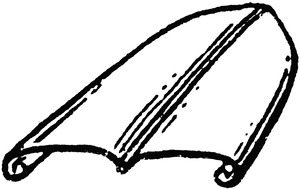 with margins rolled downward, or to the lower side
with margins rolled downward, or to the lower side
rhombic: 2D shape—diamond-shaped in outline; having the form of a rhombus
2D shape—diamond-shaped in outline; having the form of a rhombus
ribbed: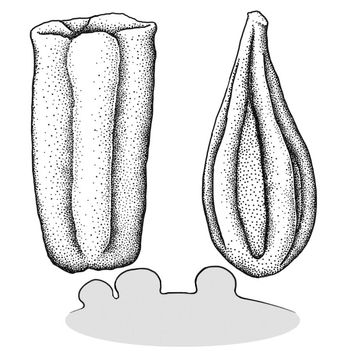 surface relief—wide, prominent, linear ridges that are generally rounded and longitudinally situated on the surface
surface relief—wide, prominent, linear ridges that are generally rounded and longitudinally situated on the surface
ridged: surface relief—raised, thick ridges, sharp edged or rounded, usually in a series that may cover the entire surface
surface relief—raised, thick ridges, sharp edged or rounded, usually in a series that may cover the entire surface
roughened: texture—having a small, stout, stiff, more or less acute protrusions
round: 2D shape—orbiculate; circular
2D shape—orbiculate; circular
rudimentary: (of embryo) embryo is small and fills less than a quarter of the seed and can be variable in shapes, such as linear, spatulate, or oval
(of embryo) embryo is small and fills less than a quarter of the seed and can be variable in shapes, such as linear, spatulate, or oval
rugose: =wrinkled
=wrinkled
ruminate: testa or seed coat folded into the endosperm
testa or seed coat folded into the endosperm
samara: a winged, indehiscent, dry fruit containing a single (rarely two) seed(s)
a winged, indehiscent, dry fruit containing a single (rarely two) seed(s)
sarcotesta: pulpy or fleshy outer layer of the seed coat, simulates aril
pulpy or fleshy outer layer of the seed coat, simulates aril
scabrate: surface relief—rough, having small, stout, stiff, more or less acute protrusions
scale: general term for short, thin, flat bracts or hairs
scaly: surface relief—covered with small, thin, fine scales or flakes that may be removable
surface relief—covered with small, thin, fine scales or flakes that may be removable
scarious: texture—dry, thin, membranous, non-green, more or less translucent
schizocarp: fruit formed from a single ovary, with fused carpels, with or without accessory tissue; splitting between locules to form distinct, indehiscent, usually one seeded segments; usually dry, rarely fleshy (compare mericarp)
fruit formed from a single ovary, with fused carpels, with or without accessory tissue; splitting between locules to form distinct, indehiscent, usually one seeded segments; usually dry, rarely fleshy (compare mericarp)
sclerified: texture—hardened
scutellum: the single, relatively large cotyledon of a grass embryo
the single, relatively large cotyledon of a grass embryo
sectoroid: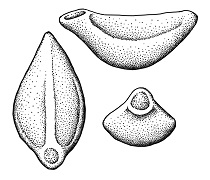 3D shape—a wedge-shaped slice taken from an ovoid or globose structure (2D shape, sector-shaped)
3D shape—a wedge-shaped slice taken from an ovoid or globose structure (2D shape, sector-shaped)
sepal: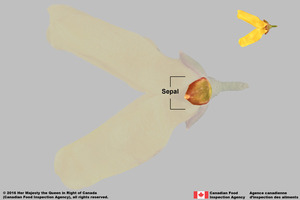 a member of the outer envelope of a flower (calyx)
a member of the outer envelope of a flower (calyx)
septate: structure with one or more septa
septicidal: type of capsular dehiscence, opening longitudinally by separating between the septa of adjacent carpels
type of capsular dehiscence, opening longitudinally by separating between the septa of adjacent carpels
septifragal: type of capsular dehiscence, splitting through the exterior wall suture(s) but not the septum(-a), the valves of the wall then separating from the septum(-a) and the locules thus opened directly to the outside
septum: (pl. septa) a dividing cross wall or partition
(pl. septa) a dividing cross wall or partition
serrate: having a saw-toothed margin, i.e., a margin notched with toothlike projections
having a saw-toothed margin, i.e., a margin notched with toothlike projections
serrulate: a minutely serrate margin
a minutely serrate margin
sessile: attached without a stalk
attached without a stalk
shiny: uniformly reflecting a high proportion of incident light at all angles
uniformly reflecting a high proportion of incident light at all angles
silique: (includes silicle) a fruit derived from a 2-carpellate gynoecium in which the two halves of the fruit split away from a persistent partition (around the rim of which the seeds are attached)
(includes silicle) a fruit derived from a 2-carpellate gynoecium in which the two halves of the fruit split away from a persistent partition (around the rim of which the seeds are attached)
simple: fruit formed from a single flower with one pistil, solitary carpel or several fused carpels
sorosis: a multiple fruit composed of two or more fleshy fruitlets that developed on a peduncle
spatulate: 2D shape—like a spatula; rounded at the apex, with base long and tapered; (of embryo) embryo is straight and axile and centric with the cotyledons expanded to form the shape of a spatula or spoon; (of cotyledons) cotyledons expanded and wider than the stalk but not invested into the stalk
2D shape—like a spatula; rounded at the apex, with base long and tapered; (of embryo) embryo is straight and axile and centric with the cotyledons expanded to form the shape of a spatula or spoon; (of cotyledons) cotyledons expanded and wider than the stalk but not invested into the stalk
spherical: 3D shape—globose
spicule: a small, pointed, epidermal appendage
spikelet: basic unit of the grass inflorescence, commonly consisting of a pair of glumes and one to many florets
basic unit of the grass inflorescence, commonly consisting of a pair of glumes and one to many florets
spiny: having slender, stiff, sharp projections oriented in the general plane of the structure
having slender, stiff, sharp projections oriented in the general plane of the structure
spongy: soft, light, discontinuous but cohesive, and somewhat resilient
square: 2D shape—geometric figure bounded by 4 straight sides of equal length and 4 90º-angles
staminodes: a modified, sterile stamen
star-shaped: (of fruit), having a distal aspect like the stylized shape of a star, usually found in aggregate versus simple fruit
(of fruit), having a distal aspect like the stylized shape of a star, usually found in aggregate versus simple fruit
stellate: star-shaped; with radiating branches
star-shaped; with radiating branches
sterile: lacking male and/or female reproductive parts; also, not producing fruit or seed
lacking male and/or female reproductive parts; also, not producing fruit or seed
stigma: the portion of the pistil receptive to pollen
the portion of the pistil receptive to pollen
stipe: a stalk
stipitate: borne on a stalk
striate: surface relief—having fine, parallel lines, grooves or ridges
surface relief—having fine, parallel lines, grooves or ridges
strophiole: appendage or outgrowth of seed coat near the hilum and micropyle
style: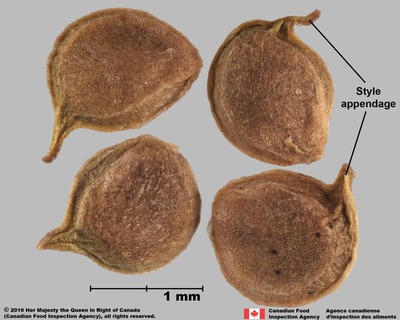 in a flower, the narrow and elongated part of the pistil between the stigma and the ovary; sometimes persisting in fruit
in a flower, the narrow and elongated part of the pistil between the stigma and the ovary; sometimes persisting in fruit
style base: remnant of a style
remnant of a style
stylopodium: a discoid enlargement at the base of the styles, esp. in Apiaceae
sub-: a prefix meaning slightly, somewhat, or nearly (used with a descriptive term), or below (used with an anatomical term)
subglobose: 3D shape—almost globose
succulent: texture—herbaceous and juicy, often thickened
sulcate: surface relief—having one or more elongate, relatively narrow and shallow depressions or grooves
surface relief—having one or more elongate, relatively narrow and shallow depressions or grooves
superior: ovary not enclosed to any degree by a floral tube casing, the perianth and/or androecium thus arising beneath (proximal to) it
suture: a line of fusion; a seam
syncarp: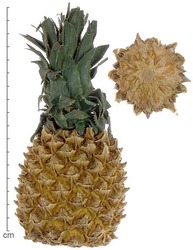 fruit derived from fusion of numerous ovaries in a many-flowered inflorescence or a flower with numerous carpels
fruit derived from fusion of numerous ovaries in a many-flowered inflorescence or a flower with numerous carpels
syncarpous: gynoecium with two or more united carpels
tawny: brownish-yellow; tan
teardrop-shaped: 2D shape—widest point is toward one end of the fruit, the other end tapers sharply to a pointed end
2D shape—widest point is toward one end of the fruit, the other end tapers sharply to a pointed end
tepal: a member of the perianth, when it cannot be differentiated into a calyx and corolla
a member of the perianth, when it cannot be differentiated into a calyx and corolla
terete: approximately circular in cross section; width and thickness approximately equal
approximately circular in cross section; width and thickness approximately equal
testa: seed coat
seed coat
thick: having or being of relatively great depth
thin: having or being of relatively little depth
tomentellous: surface relief—slightly tomentose
tomentose: surface relief—pubescence that is bent and matted, forming a woolly coating; often the hairs are silver or gray-colored
surface relief—pubescence that is bent and matted, forming a woolly coating; often the hairs are silver or gray-colored
torulose: 3D shape—a cylindrical or ellipsoid body that is swollen and constricted at intervals
3D shape—a cylindrical or ellipsoid body that is swollen and constricted at intervals
transection: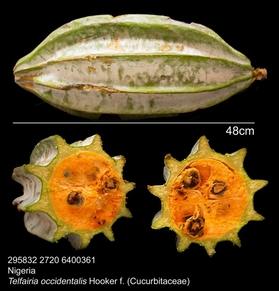 a cross section; representing a plane made by cutting across an organ at a right angle to its length
a cross section; representing a plane made by cutting across an organ at a right angle to its length
translucent: transmitting light uniformly and diffusely
transmitting light uniformly and diffusely
transverse: lying, situated, or placed across
triangular: 2D shape—three relatively straight sides with distinct corners; more angular than teardrop-shaped
2D shape—three relatively straight sides with distinct corners; more angular than teardrop-shaped
trichome: a hair or hairlike outgrowth of the epidermis
a hair or hairlike outgrowth of the epidermis
trigonous: 3D shape—having three faces that meet at distinct angles; triangular in outline
trilocular: (ovary or fruit) having three locules
truncate: terminating abruptly, as if cut straight across
terminating abruptly, as if cut straight across
tuberculate: surface relief—bearing small, warty, swelling, rounded, or variously shaped projections
surface relief—bearing small, warty, swelling, rounded, or variously shaped projections
tubuliform: having the form of a tube or cylinder
turbinate: 3D shape—broadly obovoid-obconic
umbo: a rounded protuberance on both faces of some seeds in the Mimosoideae, such as those of Prosopis
a rounded protuberance on both faces of some seeds in the Mimosoideae, such as those of Prosopis
undulate: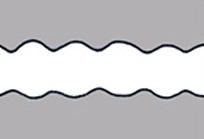 wavy-margined
wavy-margined
uniseriate: arranged in a single row; e.g. seeds arranged in a single row within a locule
urceolate: 3D shape—urn-shaped, hollow and contracted near the apex
utricle: a small, indehiscent, dry fruit with a thin wall (bladderlike) that is loose and free from the seed
a small, indehiscent, dry fruit with a thin wall (bladderlike) that is loose and free from the seed
valve: in fruits, one of the parts into which a fruit separates at maturity
in fruits, one of the parts into which a fruit separates at maturity
veined: surface relief—lines that intersect in a vein pattern that is flush or slightly raised from the surface
surface relief—lines that intersect in a vein pattern that is flush or slightly raised from the surface
ventral: adaxial; of the side of an organ facing the axis (compare dorsal)
adaxial; of the side of an organ facing the axis (compare dorsal)
verrucose: surface relief—warty, covered with wart-like projections
villous: surface relief—covered with long, soft, fine hairs
surface relief—covered with long, soft, fine hairs
vitta: (pl. vittae) an oil or resin tube in the pericarp of many Apiaceae fruits
waisted: in grass caryopses, refers to an embryo visible on the caryopsis surface that is constricted in the middle
warty: surface relief—distinct, rounded projections that are large relative to the fruit size; tuberculate, verrucose
surface relief—distinct, rounded projections that are large relative to the fruit size; tuberculate, verrucose
wedge-shaped: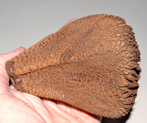 2D shape—triangular and tapering to a point at the base
2D shape—triangular and tapering to a point at the base
with hooks: bristles or spines with curved or backwards pointing tips, or with secondary bristles along their length
bristles or spines with curved or backwards pointing tips, or with secondary bristles along their length
with spikes: thick outgrowths that have a flared base and are thicker than spines
thick outgrowths that have a flared base and are thicker than spines
woody: consisting mainly of indurate lignified tissues, characteristic of or resembling wood
wrinkled: surface relief—shallow, irregular folds and furrows covering the surface; appearing overall though crumpled and then spread out
surface relief—shallow, irregular folds and furrows covering the surface; appearing overall though crumpled and then spread out